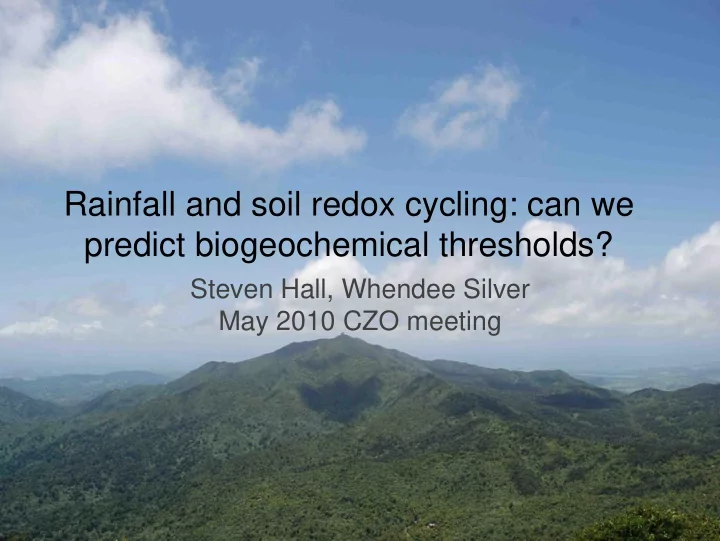

Rainfall and soil redox cycling: can we predict biogeochemical thresholds? Steven Hall, Whendee Silver May 2010 CZO meeting
Redox Cycling: • Definition: the rapid (hours to days) conversion of chemical species from oxidized to reduced forms, and back again QUESTIONS • How do static vs. pulsed rainfall regimes affect redox cycling in soil? • Over what time scales does redox cycling occur? • Can redox cycling help us better understand trace gas emissions and other critical zone processes?
A Redox Primer • pE is a measure of electron abundance, or “redox potential” pH = 5 • pE values are associated with distinct terminal electron accepting processes (TEAPs) • High pE ~ oxidizing • low pE ~ reducing
Redox and Soils • Knowing which redox reactions dominate could help us predict greenhouse gas fluxes in the field • Could also predict mineral transformations, rock weathering, mercury methylation...
Redox Potential in the Field • O 2 is highly dynamic over space and time • Influence of rainfall? • A redox ladder or a milieu of redox-sensitive processes? • Is the TEAP model useful Soil O 2 over time (Silver et al. 1999, in tropical forest soils? Biogeochemistry)
First Hypotheses: • 1: Repeated periods of intense rainfall followed by rainfall exclusion will drive redox cycles between oxidized and reduced chemical species • 2: Fluctuating rainfall regimes will increase the total number of redox cycles relative to continuous rainfall or rainfall exclusion • 3: Increased redox cycling will decrease soil- atmosphere fluxes of CH 4 and CO 2 but increase fluxes of N 2 O
Redox Reactions of Interest: • Iron reduction Fe(III) -> Fe(II): • Can account for up to 44% of C mineralization (Dubinsky et al. 2010), and can occur under an aerobic headspace (Liptzin and Silver 2009) • Can suppress CH 4 production (Teh et al. 2008) • Nitrate reduction (NO 3- -> N 2 O, N 2 , or NH 4 + ...) • Various pathways for ecosystem nitrate loss or retention • Several new mechanisms unraveled in Luquillo soils, but temporal dynamism still poorly described
Redox Reactions of Interest: • Manganese reduction (Mn(IV) -> Mn(II): • Likely suppresses CH4 production, but not yet measured in Luquillo soil • Thermodynamically more favorable than iron reduction • Sulfate reduction (SO 42- -> H 2 S) • Low rates recently measured in three Luquillo soils (2 nmol g -1 d -1 ) • Likely suppresses CH4 production • Co-occurs with mercury methylation
Field experiments • Bisley watershed • 32-day field campaigns • Throughfall exclusion, supplemental watering by treatment: • (1) Daily watering • (2) No watering • (3) Four-day watering cycles • (4) Eight-day watering cycles • (5) Ambient control
Instrumentation and Sampling Area of water • PVC collars application • Buried soil gas chamber, O 2 sensors 1.5 x 1.5-m throughfall • Tension exclusion plot lysimeters • Soil moisture probes
Measurements • Soil moisture and O 2 concentration data (continuous) • Soil atmosphere concentrations of CO 2 , CH 4 , N 2 O (daily) • Soil surface fluxes of CO 2 , CH 4 , N 2 O (every eight days) • Soil porewater analysis of Mn, Fe, NO 3- , NH 4 + , SO 42- , DOC, DON; soil extractions of the same species (every eight days) • Soil extracellular enzyme activity
Goals • Building a “bottom - up” framework for incorporating redox cycling into models of soil greenhouse gas fluxes • Predicting threshold effects of global change on biogeochemical cycling
Complex effects of redox dynamics • Oxidative extracellular enzymes (e.g. phenol Lignified organic matter oxidase) may represent an “enzymatic latch” on soil C (Freeman et al. 2001) -O2 • Fluctuating redox could +O2 affect the activity of Slow oxidative extracellular degradation Oxidative enzyme attack enzymes Rapid degradation • Effects on enzyme more CO2 synthesis and persistence are unknown
Recommend
More recommend